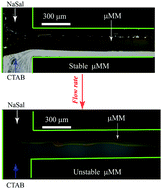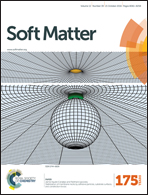Formation and flow behavior of micellar membranes in a T-shaped microchannel†
Abstract
Understanding the formation and instability behavior of membranes is of fundamental interest and practical relevance to various biotechnological applications and self-assembly systems. Surfactant micellar membranes serve as a simple model system when surfactant molecules self-assemble into micellar structures under flow, but observing such process in real time is a major challenge due to limitations in spatiotemporal resolutions. We use a simple T-shaped microchannel to capture the formation and flow behavior of an ionic surfactant micro-micellar-membrane (μMM) when an aqueous stream of organic salt sodium salicylate (NaSal) meets a stream of cationic surfactant cetyltrimethylammonium bromide (CTAB). The μMM is shown to grow and become unstable depending on the flow rate, as characterized using micro-particle image velocimetry, fluorescence microscopy, flow birefringence, and bulk rheometry. We propose a simple model that accounts for the flow, elasticity and inertia of the μMM to analyze its flow behavior. Our experimental protocol can be easily replicated in conventional laboratories without the need of utilizing sophisticated equipment such as synchrotron small angle X-ray scattering and micro-electronics circuits. Our combined experimental and modeling results can be extrapolated to provide new insights to study the flow behavior and thermodynamic phases of lipid membranes, membrane proteins, and biological membranes.


 Please wait while we load your content...
Please wait while we load your content...